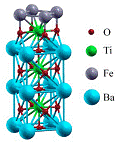Department of Physics and Astronomy: Publications and Other Research

Evgeny Tsymbal Publications
ORCID IDs
Tsymbal http://orcid.org/0000-0002-6728-5481
Paudel https://orcid.org/0000-0002-9952-9435
Document Type
Article
Date of this Version
8-13-2019
Citation
Proceedings of the National Academy of Sciences (August 13, 2019) 116: 16,186-16,191
doi: 10.1073/pnas.1812822116
Edited by Qi Li, Pennsylvania State University, and accepted by Editorial Board Member Tobin J. Marks
Supplemental material is available at https://www.pnas.org/lookup/suppl/doi:10.1073/pnas.1812822116/-/DCSupplemental
Abstract
Spin-orbit coupling (SOC), the interaction between the electron spin and the orbital angular momentum, can unlock rich phenomena at interfaces, in particular interconverting spin and charge currents. Conventional heavy metals have been extensively explored due to their strong SOC of conduction electrons. However, spin-orbit effects in classes of materials such as epitaxial 5d-electron transition-metal complex oxides, which also host strong SOC, remain largely unreported. In addition to strong SOC, these complex oxides can also provide the additional tuning knob of epitaxy to control the electronic structure and the engineering of spin-to-charge conversion by crystalline symmetry. Here, we demonstrate room-temperature generation of spin-orbit torque on a ferromagnet with extremely high efficiency via the spin-Hall effect in epitaxial metastable perovskite SrIrO3.We first predict a large intrinsic spin-Hall conductivity in orthorhombic bulk SrIrO3 arising from the Berry curvature in the electronic band structure. By manipulating the intricate interplay between SOC and crystalline symmetry, we control the spin-Hall torque ratio by engineering the tilt of the corner-sharing oxygen octahedra in perovskite SrIrO3 through epitaxial strain. This allows the presence of an anisotropic spin-Hall effect due to a characteristic structural anisotropy in SrIrO3 with orthorhombic symmetry. Our experimental findings demonstrate the heteroepitaxial symmetry design approach to engineer spin-orbit effects. We therefore anticipate that these epitaxial 5d transition-metal oxide thin films can be an ideal building block for low-power spintronics.


Comments
Copyright 2019, National Academy of Sciences. Used by permission
License: PNAS license